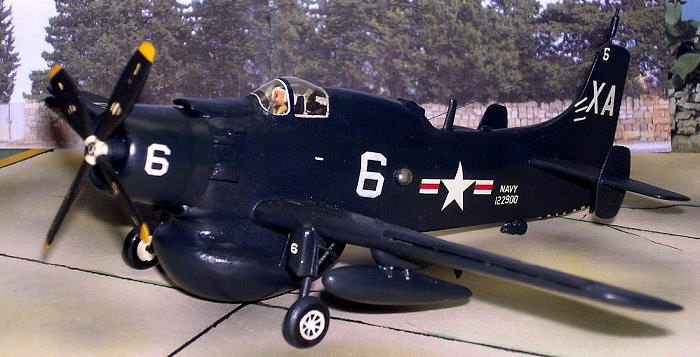
Airfix 1/72 AD-4W Skyraider
| KIT #: | ? |
| PRICE: | $ |
| DECALS: | ? |
| REVIEWER: | Carmel J. Attard |
| NOTES: | Conversion |

| HISTORY |
 When the Douglas Skyraider
AD-4W entered service, the United States Navy possessed an aircraft
equipped with powerful radar equipment that extended the task force
fleet coverage beyond the horizon and provided protection from low-level
attack intruders and at the same time acted as an airborne ‘operations’
room. The radome provided 360 degrees coverage. Because of its
appearance the AD-4W was nicknamed,’ Guppy’. To solve stall problems the
aircraft was fitted with a fixed leading edge slat on the outer wing
section. This also improved handling at low speeds during approach and
landing on carrier decks. The 3-seat early warning aircraft were also
supplied to the Royal Navy under the Mutual Defence Assistance
Programme. There were 50 of the type that were transferred to the RN
under the designation Skyraider AEW Mk1. 118 aircraft of the type
remaining in the USN service were fitted for the ‘E’ search part of the
anti-submarine mission. A total of 168 were built. In due course 14 AEW
Mk1s went to
When the Douglas Skyraider
AD-4W entered service, the United States Navy possessed an aircraft
equipped with powerful radar equipment that extended the task force
fleet coverage beyond the horizon and provided protection from low-level
attack intruders and at the same time acted as an airborne ‘operations’
room. The radome provided 360 degrees coverage. Because of its
appearance the AD-4W was nicknamed,’ Guppy’. To solve stall problems the
aircraft was fitted with a fixed leading edge slat on the outer wing
section. This also improved handling at low speeds during approach and
landing on carrier decks. The 3-seat early warning aircraft were also
supplied to the Royal Navy under the Mutual Defence Assistance
Programme. There were 50 of the type that were transferred to the RN
under the designation Skyraider AEW Mk1. 118 aircraft of the type
remaining in the USN service were fitted for the ‘E’ search part of the
anti-submarine mission. A total of 168 were built. In due course 14 AEW
Mk1s went to
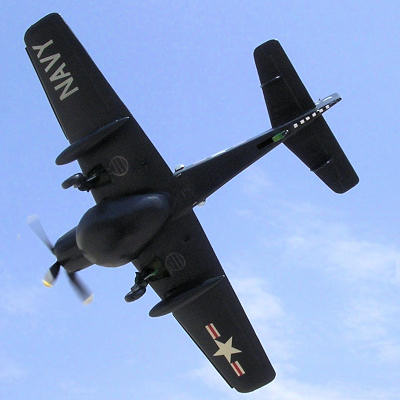 The Skyraider AD-4W also
had connections with Malta where going back to 1956, the time of the
Suez Campaign it was a common sight for anyone driving past Hal-Far
airfield one could spot the AEW version of the Avenger wearing the pale
yellow and black Suez invasion stripes and alongside was the Skyraider
AEW Mk1 which was already in service. Over the years that followed it
was common to spot a flight of three or four Skyraiders AEW Mk1 parked
at the aft flight deck of HMS Ark Royal, Hermes, Victorious and Centaur
whenever any of these carriers entered the Grand Harbour at Valletta or
when berthed at St Paul’s Bay. These AEW aircraft entered service with
778 Squadron at
The Skyraider AD-4W also
had connections with Malta where going back to 1956, the time of the
Suez Campaign it was a common sight for anyone driving past Hal-Far
airfield one could spot the AEW version of the Avenger wearing the pale
yellow and black Suez invasion stripes and alongside was the Skyraider
AEW Mk1 which was already in service. Over the years that followed it
was common to spot a flight of three or four Skyraiders AEW Mk1 parked
at the aft flight deck of HMS Ark Royal, Hermes, Victorious and Centaur
whenever any of these carriers entered the Grand Harbour at Valletta or
when berthed at St Paul’s Bay. These AEW aircraft entered service with
778 Squadron at
In US Navy service the
type operated at any one time alongside earlier types as the Avenger and
the Guardian all of which were equipped with
| THE KIT |
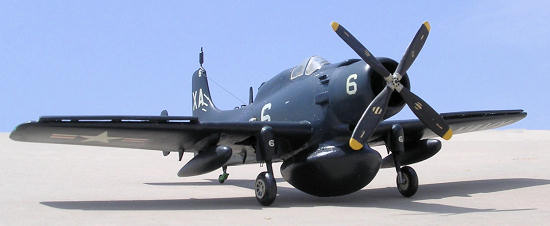 There was no known 1/72 scale
Skyraider
AEW
kit at the time it was built.
Making an AD-4W involved modifying the Airfix A-1J Skyraider kit
using a good set of 1/72-scale drawings. This was something of a challenge
as there was no known conversion kit available like there is for the Avenger
AEW. Later I learned that a conversion kit by ‘C’ scale, VJ Henley of
There was no known 1/72 scale
Skyraider
AEW
kit at the time it was built.
Making an AD-4W involved modifying the Airfix A-1J Skyraider kit
using a good set of 1/72-scale drawings. This was something of a challenge
as there was no known conversion kit available like there is for the Avenger
AEW. Later I learned that a conversion kit by ‘C’ scale, VJ Henley of
| CONSTRUCTION |
 The Airfix A-1J fuselage were
separated from the sprues and each half had a 1/8” hole drilled on each side
just above the forward upper corner of the dive brakes. The holes are then
filed to an oval shape measuring approximately 1/8” x 3/16” diagonally.
These form the windows of the radar operator accommodation. Pair of bulged
windows was molded using clear acetate and were put aside until later. For
this mold process a piece of plastic sprue had an end shaped by filing to
that of the required windows. A slightly larger similar hole is drilled and
shaped in a sheet of plywood. A square piece of acetate sheet was heated and
as soon as the edges start to curl this was then soft enough so the male
mold is pushed through to form each astrodome shaped window. These were then
push fitted from inside the fuselage halves. I did not bother to detail the
interior apart from adding a seat and floor from spares as little could be
seen of the interior from the bulging windows.
The Airfix A-1J fuselage were
separated from the sprues and each half had a 1/8” hole drilled on each side
just above the forward upper corner of the dive brakes. The holes are then
filed to an oval shape measuring approximately 1/8” x 3/16” diagonally.
These form the windows of the radar operator accommodation. Pair of bulged
windows was molded using clear acetate and were put aside until later. For
this mold process a piece of plastic sprue had an end shaped by filing to
that of the required windows. A slightly larger similar hole is drilled and
shaped in a sheet of plywood. A square piece of acetate sheet was heated and
as soon as the edges start to curl this was then soft enough so the male
mold is pushed through to form each astrodome shaped window. These were then
push fitted from inside the fuselage halves. I did not bother to detail the
interior apart from adding a seat and floor from spares as little could be
seen of the interior from the bulging windows.
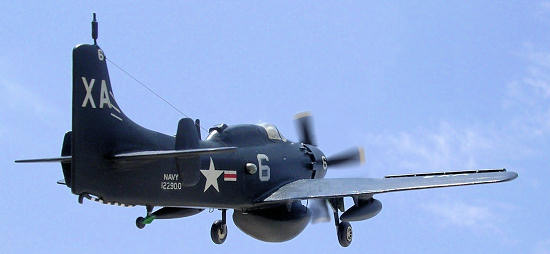 The cockpit canopy also
differed from that on the A1J and a male mold was prepared and a new canopy
molded in same manner as applied to produce the side bulged windows. The
cabin roof extension was made from a block of balsa approximately 1.75”
long’ which was glued with addition to top of fuselage behind pilot’s seat.
This was shaped by sanding followed by a coat of Humbrol sanding sealer. The
large fuselage air brakes were glued in place and covered with filler.
Instead there was a door on each side forming access to the radar operator.
The air intake forward of cowling was cut back in line to rest of engine
cowling gills. The radome was made from a yellow pine pattern carved with
forming chisels and sanding. Two radomes were cast in aluminium, one being
spare. Leading edge slots to either side of wing sections were shaped from a
strip of thin plastic
The cockpit canopy also
differed from that on the A1J and a male mold was prepared and a new canopy
molded in same manner as applied to produce the side bulged windows. The
cabin roof extension was made from a block of balsa approximately 1.75”
long’ which was glued with addition to top of fuselage behind pilot’s seat.
This was shaped by sanding followed by a coat of Humbrol sanding sealer. The
large fuselage air brakes were glued in place and covered with filler.
Instead there was a door on each side forming access to the radar operator.
The air intake forward of cowling was cut back in line to rest of engine
cowling gills. The radome was made from a yellow pine pattern carved with
forming chisels and sanding. Two radomes were cast in aluminium, one being
spare. Leading edge slots to either side of wing sections were shaped from a
strip of thin plastic
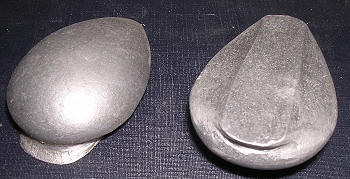 card 2mm X 51mm long. These were fixed to the leading
edge angled at 45 degrees. Actuating jacks to the leading edge slats were
made from small pieces of stretch sprue. The under-wing locating slots for
the pylons were filled with filler and sanded smooth.
card 2mm X 51mm long. These were fixed to the leading
edge angled at 45 degrees. Actuating jacks to the leading edge slats were
made from small pieces of stretch sprue. The under-wing locating slots for
the pylons were filled with filler and sanded smooth.
The wheel wells on the AD4W
which retract backwards were made by cutting a piece of plastic card to fit
new shape of opening on the underside of the wings and a circular section
proud of wheels diameter is cut out in this position where the legs lays
when retracted. Undercarriage assembly was fixed in the locating slots and
an under wing pylons added and a pair of fuel tanks prepared. A set of
auxiliary fins are cut from thin plastic card and cemented to tail planes. A
blade aerial was added aft of cockpit, also cut from plastic card. Cabin
ventilation louver was shaped from a piece of plastic and glued over cabin.
The pitot tube on top of fin was made from hollow tube and a string of steel
wire passing through.
| COLORS & MARKINGS |
The AD4W model was washed,
dried and airbrushed in
| CONCLUSIONS |
 As one would expect, converting a
model into a different known version will leave a feeling of satisfaction. One
thing leads into another and although these days many different types of kits
are being released there are still several types out there that can be made from
kit conversions.
As one would expect, converting a
model into a different known version will leave a feeling of satisfaction. One
thing leads into another and although these days many different types of kits
are being released there are still several types out there that can be made from
kit conversions.
May 2011
If you would like your product reviewed fairly and fairly quickly, please contact the editor or see other details in the Note to Contributors.